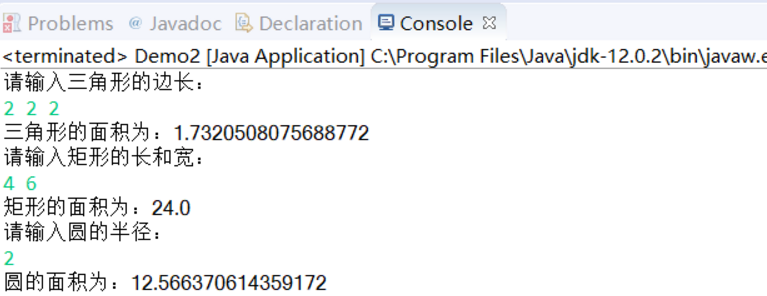第七周
实验四 类的继承
实验目的
理解抽象类与接口的使用;
了解包的作用,掌握包的设计方法。
实验要求
掌握使用抽象类的方法。
掌握使用系统接口的技术和创建自定义接口的方法。
了解 Java 系统包的结构。
掌握创建自定义包的方法。
实验内容
(一)抽象类的使用
设计一个类层次,定义一个抽象类--形状,其中包括有求形状的面积的抽象方法。 继承该抽象类定义三角型、矩形、圆。 分别创建一个三角形、矩形、圆存对象,将各类图形的面积输出。
注:三角形面积s=sqrt(p(p-a)(p-b)*(p-c)) 其中,a,b,c为三条边,p=(a+b+c)/2
2.编程技巧
(1) 抽象类定义的方法在具体类要实现;
(2) 使用抽象类的引用变量可引用子类的对象;
(3) 通过父类引用子类对象,通过该引用访问对象方法时实际用的是子类的方法。可将所有对象存入到父类定义的数组中。
实验代码:
package hello;
import java.util.Scanner;
abstract class Shape {
public abstract double Area();
}
class Triangle extends Shape{
private int a,b,c;
public Triangle() {}
public Triangle(int a,int b,int c){
this.a = a;
this.b = b;
this.c = c;
}
public int getA() {
return a;
}
public void setA(int a) {
this.a = a;
}
public int getB() {
return b;
}
public void setB(int b) {
this.b = b;
}
public int getC() {
return c;
}
public void setC(int c) {
this.c = c;
}
public double Area() {
double p = (a+b+c)/2;
return Math.sqrt(p*(p-getA())*(p-getB())*(p-getC()));
}
}
class Rectangle extends Shape{
private double height,width;
public Rectangle() {}
public Rectangle(double height,double width){
this.height = height;
this.width = width;
}
public double getHeight() {
return height;
}
public void setHeight(double height) {
this.height = height;
}
public double getWidth() {
return width;
}
public void setWidth(double width) {
this.width = width;
}
public double Area() {
return getHeight()*getWidth();
}
}
class Circle extends Shape{
private double radius;
public Circle(){}
public Circle(double radius) {
this.radius = radius;
}
public double getRadius() {
return radius;
}
public void setRadius(double radius) {
this.radius = radius;
}
public double Area() {
return Math.PI*Math.pow(getRadius(), 2);
}
}
public class Demo2{
public static void main(String[] args) {
System.out.println("请输入三角形的边长:");
Scanner s1 = new Scanner(System.in);
int a = s1.nextInt();
int b = s1.nextInt();
int c = s1.nextInt();
Triangle triangle = new Triangle(a,b,c);
if(a+b>c && a+c>b && b+c>a) {
System.out.println("三角形的面积为:"+triangle.Area());
}
else {
System.out.println("这不是一个三角形,无法输出面积。");
}
Scanner s2 = new Scanner(System.in);
System.out.println("请输入矩形的长和宽:");
double height = s2.nextDouble();
double width = s2.nextDouble();
Rectangle rectangle = new Rectangle(height,width);
System.out.println("矩形的面积为:"+rectangle.Area());
Scanner s3 = new Scanner(System.in);
System.out.println("请输入圆的半径:");
double radius = s3.nextDouble();
Circle circle = new Circle(radius);
System.out.println("圆的面积为:"+circle.Area());
}
}
截图:
(二)使用接口技术
1、定义接口Shape,其中包括一个方法size(),设计“直线”、“圆”、类实现Shape接口。分别创建一个“直线”、“圆”对象,将各类图形的大小输出。
2、编程技巧
(1) 接口中定义的方法在实现接口的具体类中要重写实现;
(2) 利用接口类型的变量可引用实现该接口的类创建的对象。
实验代码:
package hello;
import java.util.Scanner;
interface Shape{
public void Size();
}
class Line implements Shape{
private double length;
public Line() {}
public Line(double length) {
this.setLength(length);
}
@Override
public void Size() {
System.out.println("直线的长度:"+getLength());
}
public double getLength() {
return length;
}
public void setLength(double length) {
this.length = length;
}
}
class Circle implements Shape{
private double radius;
public Circle(double radius) {
this.radius = radius;
}
public double getRadius() {
return radius;
}
public void setRadius(double radius) {
this.radius = radius;
}
public double getArea() {
return Math.PI*Math.pow(radius, 2);
}
@Override
public void Size() {
System.out.println("圆的面积:"+getArea());
}
}
public class Demo1{
public static void main(String[] args) {
Scanner s = new Scanner(System.in);
System.out.println("请输入直线的长度:");
int length = s.nextInt();
Line line = new Line(length);
System.out.println("直线长度为:"+line.getLength());
Scanner p = new Scanner(System.in);
System.out.println("请输入圆的半径:");
double radius = p.nextDouble();
Circle circle = new Circle(radius);
System.out.println("圆的面积为:"+circle.getArea());
}
}
截图:
学习总结:
1、抽象类与接口
(1)抽象类:抽象类必须用 abstract 修饰,子类必须实现抽象类中的抽象方法,如果有未实现的,那么子类也必须用 abstract 修饰。抽象类默认的权限修饰符为 public,可以定义为 public 或 procted,如果定义为 private,那么子类则无法继承。抽象类不能创建对象
(2)接口:接口中的变量隐式的使用 public static final 修饰,并且需要给出初始值。方法隐式的使用 public abstract 修饰(并且只能是 public ,如果是 private,procted,那么就编译报错)。
(3)接口和抽象类的区别:
a.抽象类只能继承一次,但是可以实现多个接口
b.接口和抽象类必须实现其中所有的方法,抽象类中如果有未实现的抽象方法,那么子类也需要定义为抽象类。抽象类中可以有非抽象的方法
c.接口中的变量必须用 public static final 修饰,并且需要给出初始值。所以实现类不能重新定义,也不能改变其值。
d.接口中的方法默认是 public abstract,也只能是这个类型。不能是 static,接口中的方法也不允许子类覆写,抽象类中允许有static 的方法
2、Object类
(1)toString():将一个对象转换成字符串形式体现出来,也是最常用的一个方法
(2)equals():制定一个类型的比较规则
(3)hashCode():生成一个对象的散列码




